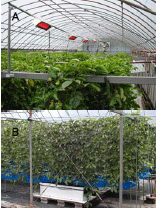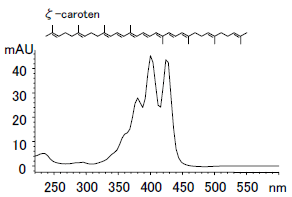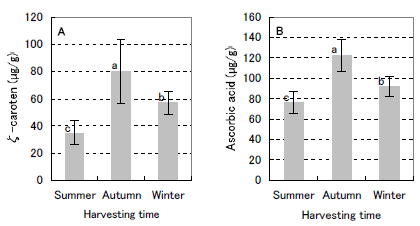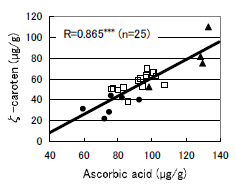Evaluation of functional components in passionfruit cultivated under drip-fertigation and light culture
Description
Passionfruit is produced from South Kyushu to Okinawa in Japan and is consumed as a table fruit or as juice. The flavor is appealing and the taste is subacid to acid. Passionfruit contains many functional components such as carotenoids and ascorbic acid. In open field culture, passionfruit is harvested only in summer and winter. However, it is possible to harvest it in autumn as well by using drip-fertigation and light culture, which comprises drip-fertigation culture that allows optimum control of fertilizer application and ground temperature, and light culture using energy-efficient red LEDs that induce flower bud formation (Fig. 1). We attempt to identify contained in passionfruit and examine the influence of harvesting season on the quantity of the functional components under drip-fertigation and light culture.
‘Summer Queen’ passionfruit used in this study was collected from the Kagoshima Fruit Tree Experimental Station. As a result of analyzing the juice of the passionfruit using HPLC, it was found from the absorption spectrum that the main carotenoid in the passionfruit was z- carotene (Fig. 2). The UV-visible spectrum of z-carotene showed lmax at 379, 400 and 425, with high spectral fine structure (%III/II 93). After filtering the passionfruit juice on a Sep-Pak C18 cartridge, the concentration of ascorbic acid was rapidly and simply determined using the Reflectoquant Ascorbic Acid Test (Merck Ltd., Japan) without the need to use HPLC. The quantities of z-carotene and ascorbic acid in the passionfruit juice varied significantly according to harvesting season (Fig. 3). The concentrations of z-carotene and ascorbic acid were significantly higher in fruits harvested in autumn than in summer and winter. There was a direct correlation between z-carotene and ascorbic acid content (Fig. 4) that was not influenced by harvesting season, making it possible to estimate the concentration of z-carotene by measuring the concentration of ascorbic acid using the Reflectoquant Ascorbic Acid Test.
These results indicate that drip-fertigation and light culture is useful for harvesting autumn fruit that contains numerous functional contents.
Figure, table
-
Fig. 1. Light culture by red LEDs (A) and drip-fertigation (B) of passionfruit. -
Fig. 2. UV-visible spectrum of major carotenoid fraction (retention time = 59.29 min).
The conditions were as follows: column, YMC carotenoid S5 µm (4.6 x 250 mm); temperature, 40 ˚C; flow rate, 1.0 mL/min; mobile phase, A: 20% (v/v) MeOH in H2O, B: MTBE: MeOH (9:1); gradient, 26% B hold for 15 min, to 34% B in 25 min, to 44% B in 10 min, to 56% B in 15 min, hold for 10 min, then back to 26% in 5 min.
The structural formula of z-carotene is illustrated. -
Fig. 3. Concentration of z-carotene (A) and ascorbic acid (B) in the juice of ‘Summer Queen’ passionfruit.The concentration of z-carotene is *measured as b-carotene corresponding.
Vertical bars indicate SE (n = 4-15). Different letters are significant at P < 0.05 according to the Tukey-Kramer HSD test. -
Fig. 4. Relationship between contents of ζ-carotene and ascorbic acid in juice of ‘Summer Queen’ harvested in summer (●), autumn (▲) and winter (□).
*** Significant at the 0.1% level.
- Affiliation
-
Japan International Research Center for Agricultural Sciences Okinawa Subtropical Station
- Classification
-
Technical A
- Term of research
-
FY2005(FY2003~2005)
- Responsible researcher
-
KATO Hidenori ( Okinawa Subtropical Station )
OGAWA Kazunori ( Institute of Fruit Tree Science, NARO )
- ほか
- Publication, etc.
-
Kato, H. et al. (2005) Tropical Agriculture 49 (Supl. 2), 43-44.
- Japanese PDF




